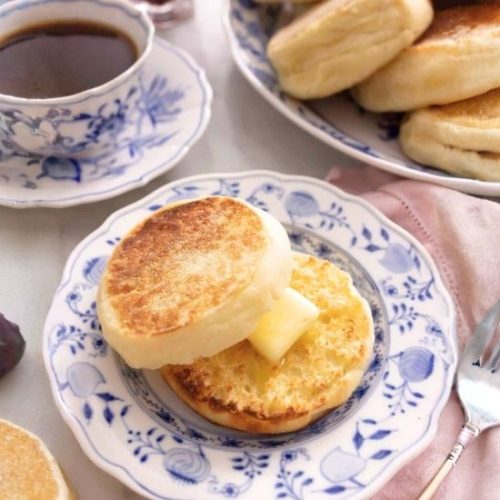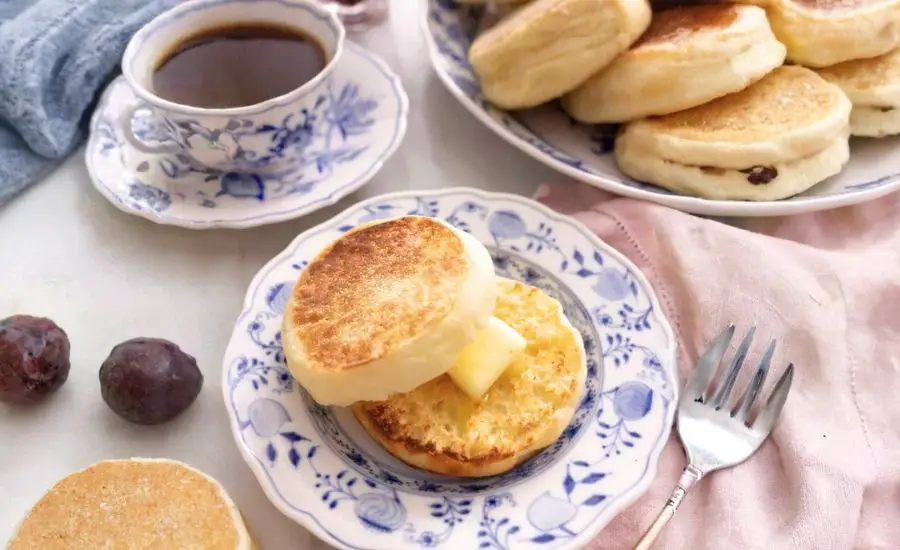All products are selected by our editorial team for quality. If you buy through our links, we may earn a small commission at no extra cost to you.
This homemade English Muffin recipe stands out with its perfect balance of lightness and a satisfyingly chewy texture.
Using a blend of milk, water, butter, and an egg enriches the dough, creating muffins that are moist inside with a golden crust, especially when cooked on a skillet with cornmeal or semolina dusting for that signature nooks-and-crannies texture.
Nutritionally, these muffins offer a moderate calorie count with 4 grams of protein and just 3 grams of fat per serving, making them a balanced choice for breakfast or snacks.
While they contain carbohydrates from flour, the recipe’s fiber content supports digestion and satiety.
This recipe is also flexible—ideal for meal prepping as the dough can be refrigerated overnight, allowing flavors to develop further.
Whether you toast them for a quick breakfast or use them as a base for savory sandwiches, these muffins are easy to make, fun to customize, and a delicious way to bring a classic bakery treat into your everyday kitchen.
Must-Have Tools for Perfect Results
Stand Mixer with Paddle Attachment
Essential for mixing and kneading the sticky dough effortlessly, ensuring smooth and elastic texture every time. Beyond muffins, it’s invaluable for all baking needs, from breads to cookies.
3-Inch Round Cutter
Perfect for shaping uniform muffins that cook evenly. It also doubles as a handy tool for cutting biscuits, scones, and cookie dough rounds.
Large Skillet or Cast Iron Pan
Provides even heat for skillet-cooking the muffins, delivering the perfect golden crust. A cast iron skillet’s versatility makes it a kitchen staple for searing, frying, and baking.
Measuring Cups and Spoons
Accurate ingredient measurement is key for baking success. These tools ensure precise amounts, improving consistency in all recipes.
Parchment Paper
Prevents sticking during proofing and baking, making cleanup easier and keeping muffins intact. Also useful for lining baking trays and rolling out dough.

English Muffins
Equipment
- 1 Large-sized skillet (for stovetop cooking)
- 1 Stand mixer with paddle attachment (for kneading dough)
- 1 3-inch round cutter (for shaping muffins)
- Measuring cups and spoons (for precise ingredient measurement)
- Parchment paper (for dusting and lining baking sheets)
Ingredients
- 2 ¾ cups 330g all-purpose flour
- 2 ¼ teaspoons instant yeast one packet
- 1 teaspoon salt
- 2 tablespoons granulated sugar
- ¾ cup 180ml whole milk
- ½ cup 120ml water
- 3 tablespoons 42g unsalted butter, melted
- 1 large egg at room temperature
- Cornmeal or semolina for dusting
Instructions
- Activate the Yeast: In a small bowl or heatproof measuring cup, combine the milk, water, and sugar. Warm gently (about 110°F/43°C) until lukewarm, then sprinkle the instant yeast over the surface. Stir lightly once and let it rest for 5 to 7 minutes until the mixture becomes foamy and bubbly, indicating the yeast is active.
- Prepare the Dry Ingredients: Meanwhile, whisk together the flour and salt in the bowl of a stand mixer fitted with the paddle attachment. This ensures even distribution of the salt throughout the flour.
- Combine Wet Ingredients: In a separate bowl, whisk the egg with the melted butter. Once the yeast mixture is bubbly, pour the egg-butter blend into it and stir to combine.
- Mix the Dough: Slowly add the wet ingredients into the flour mixture while running the mixer on low speed. Once all liquid is incorporated, increase the speed to medium-high and mix for 6 to 8 minutes, or until the dough is smooth, elastic, and slightly sticky.
- First Rise: Lightly oil a large bowl and transfer the dough into it, turning to coat all sides. Cover the bowl tightly with plastic wrap or a damp towel and place it in a warm, draft-free spot. Let it rise until doubled in size, approximately 1 hour. For deeper flavor, refrigerate overnight and bring to room temperature before proceeding.
- Shape the Muffins: Turn the dough out onto a lightly floured surface. Gently pat or roll it out until about ¾ inch thick. Dust two baking sheets with cornmeal or semolina. Using a 3-inch round cutter, stamp out circles and transfer them to the prepared sheets. Reroll scraps and repeat until all dough is used. Cover loosely and let the shaped muffins rise for 30 minutes in a warm spot.
- Cook on Skillet: Heat a large, heavy-bottomed skillet (cast iron preferred) over very low heat. Sprinkle a light layer of cornmeal or semolina on the surface. Place 3 or 4 muffins in the pan, cover, and cook for 5 to 6 minutes per side until golden brown and cooked through. Remove muffins and clear excess cornmeal before cooking the next batch.
- Serve and Store: Allow muffins to cool slightly before slicing with a serrated knife. Serve warm, ideally toasted. Store leftover muffins in an airtight container for 3 to 5 days or freeze for up to 3 months.
Notes
- For a chewier texture, substitute bread flour for all-purpose flour.
- Longer rising times (4-8 hours or overnight) enhance flavor and texture.
- If you don’t have a round cutter, shape muffins by hand into rounds about 3 inches in diameter.
- If muffins are too soft inside, briefly bake them in a 350°F oven for 3 minutes to finish cooking.
- Adding a small pat of butter to the skillet can prevent sticking if needed.
- Cooking on very low heat ensures the muffins cook through without burning.
- Using a serrated knife to slice prevents crushing the delicate crumb.
- Keep excess cornmeal off the skillet between batches to avoid burning.
Chef’s Secrets to Perfect Muffins
Making homemade English muffins truly shines when you understand a few key techniques.
First, don’t rush the yeast activation—letting it foam ensures your dough will rise beautifully and develop that airy texture.
Using a stand mixer with a paddle attachment makes handling the sticky dough much easier, though kneading by hand is possible with patience.
Patting the dough to just under an inch thick helps create those classic nooks and crannies.
Cooking on very low heat is crucial: too hot, and the outside burns before the inside cooks through.
A cast iron skillet or heavy-bottomed pan distributes heat evenly and is ideal for this step.
Dusting the cooking surface with cornmeal or semolina not only prevents sticking but adds the signature crunch on the outside.
Finally, if muffins seem undercooked inside, a brief bake in a moderate oven finishes them perfectly.
Creative Serving Suggestions to Enjoy
English muffins are incredibly versatile and make a fantastic base for many meals beyond breakfast.
Split them open with a serrated knife to reveal their signature texture, then toast until golden for extra crunch.
Spread with butter and jam for a simple treat or use as a platform for classic eggs Benedict.
For a savory twist, top with avocado slices, smoked salmon, or your favorite cheese and deli meats.
They also make great sandwich bread for lunch or dinner, pairing wonderfully with grilled chicken, turkey, or roasted veggies.
Leftover muffins can be transformed into mini pizzas or breakfast sliders—simply layer toppings and warm them up.
Their neutral flavor profile means they complement both sweet and savory dishes, making them a kitchen staple for any time of day.
Storage Tips for Freshness Longevity
To keep your English muffins fresh and delicious, store them in an airtight container at room temperature for up to 3-5 days.
Avoid storing them in the refrigerator as this can dry them out more quickly.
If you want to keep them longer, freezing is the best option—place muffins in a freezer-safe bag or container, separated by parchment paper to prevent sticking.
When ready to eat, thaw at room temperature or toast them directly from frozen for convenience.
For reheating, a toaster or oven helps restore their crisp exterior and soft interior texture.
Proper storage ensures you can enjoy homemade muffins over several days without sacrificing flavor or texture.
Frequently Asked Questions Answered
1. Can I make English muffins without a stand mixer?
Absolutely! While a stand mixer simplifies kneading the sticky dough, you can knead by hand on a floured surface for about 10-12 minutes until smooth and elastic.
2. What’s the difference between cornmeal and semolina for dusting?
Both prevent sticking and add texture, but semolina is finer and creates a slightly smoother crust, while cornmeal is coarser and adds more crunch.
3. Can I use bread flour instead of all-purpose flour?
Yes! Bread flour will result in a chewier muffin due to higher gluten content, which some people prefer for that classic English muffin bite.
4. How do I know when the muffins are cooked through?
They should be golden brown on both sides and feel firm when pressed gently. If unsure, you can finish them with a brief bake at 350°F for 3 minutes.
5. Can the dough be refrigerated before shaping?
Definitely. Refrigerating the dough overnight enhances flavor and gives you flexibility in timing. Just bring it to room temperature before shaping and proceed with the recipe.
This recipe is inspired by preppykitchen and has been carefully refined to enhance clarity, streamline preparation steps, and ensure accurate results. We’ve also included health benefits, nutritional highlights, and Must-Have Tools to help you get the best results every time you cook.


